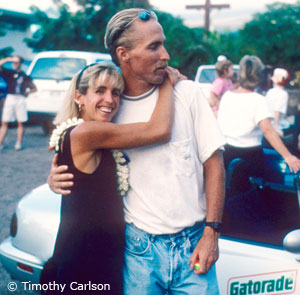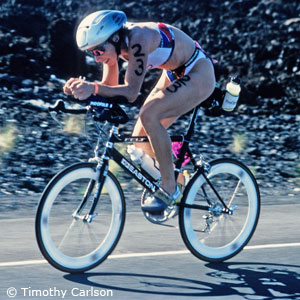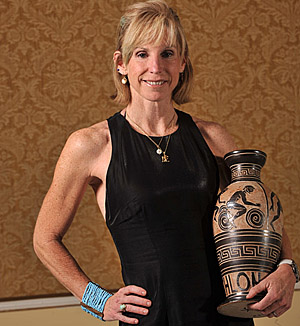It’s not so easy – part 2

"What follows is part 2 of a 4 part series printed with the publisher's permission from "17 Hours to Glory: Extraordinary Stories from the Heart of Triathlon by Mathias Müller with Timothy Carlson." 17 Hours to Glory celebrates Kona’s Ironman® heroes—from ordinary people to true triathlon legends—with seventeen inspiring stories of unbelievable drive and true strength of character. The book is available in bookstores, tri shops, and online at VeloPress.com."
Newby-Fraser started her 1992 campaign by winning the three-quarters-Ironman-distance Nice International Triathlon. Two weeks later she won her fourth Ironman Japan in 9:16:13. Just a few days later she told Huddle she felt surprisingly good. As recounted by writer Ken McAlpine, Huddle replied, “Are you saying what I think you’re saying?” Indeed, Newby-Fraser thought she could win Ironman Europe at Roth, Germany. Thirteen days later she did, in a then-world-record time of 8:55:00. While even the best triathletes take weeks to recover from the pounding and the energy-sapping dehydration of just one Ironman, Newby-Fraser had just won three Ironman-proportion events in five weeks, recording perhaps the greatest high-intensity stretch in Ironman history.
A mere 13 weeks after the European Ironman, she stepped across the finish line in Kona to take her fifth Ironman Hawaii title, setting an 8:55:28 course record that stood until 2009 and winning the women’s title by the biggest margin of the modern era, 26 minutes 12 seconds, the triathlon equivalent of Secretariat’s 31-length Belmont Stakes win.
By this time Newby-Fraser, working with superagent Murphy Reinschreiber, had built an empire of sponsorships, appearance fees, and business deals that was estimated by Inside Triathlon to bring in half a million dollars a year. It was peanuts by the standards of pro golf, tennis, and running superstars but groundbreaking in terms of the tiny niche occupied by the still emerging sport of triathlon. And in contrast to the pampered rich of mainstream sports, Newby-Fraser remained modest, utterly approachable, and without a shred of arrogance.
The following year’s preparation for Ironman Hawaii did not begin auspiciously. Newby-Fraser suffered an overtraining injury to her ankle, and the women’s field began to believe an upset was in the cards. “This year I was forced to take three months off from running and a month and a half from the bike,” said Newby-Fraser before the race, displaying a small wrap on her ankle. “This is the least prepared I have ever been for the Ironman. I just hope my years in the sport and my strength can carry me through.”
Erin Baker, the 1987 and 1990 Ironman women’s champ, wasn’t buying the “poor Paula” routine. “It would be stupid to think Paula won’t be tough,” said Baker. “But,” she added, “I expect a much better run out of myself.”
Baker herself had seemed like a prohibitive long shot, as in May she had given birth to a child. A few months later she had started training again and felt her strength return. Then Reebok offered her a three-year contract she couldn’t turn down—her husband, 1988 Ironman champion Scott Molina, was out of commission with a bad back, and Baker felt the need to take the sponsorship to support her family. She got retired Ironman champ Dave Scott to design a new training program for her Ironman. “I used to come to this race just feeling wasted,” said Baker. “But now Dave has me running shorter distances and faster times. I don’t just go out for 4-hour bike rides anymore. I run and ride shorter, faster intervals. And I feel fresher.”
Baker claimed she was stronger and more flexible since the birth of her son, Miguel, and said she was now blessed with a higher red-blood-cell count. “The birth has had the same effect as training at altitude,” she said. “All mothers get that at birth, and the increased red-blood count typically lasts nine months. And this is soon enough so it’s still true for me.” Baker added, “The most important thing is I am running harder at a lower heart rate in training. I am readier than I have ever been.”
Baker was kicked in the head right at the swim start and fell 5 minutes behind Newby-Fraser’s 53:29 swim. On the bike Newby-Fraser set a still-standing record of 4:48:30, topping Baker’s bike split by 1:36 and her own bike-split record set the previous year by 8 minutes. On the run, fighting exhaustion and lack of training mileage due to her injured ankle, Newby-Fraser held on grimly for a 3:16:54 marathon, which rewarded her with her second sub-9-hour Ironman and a final 3-2 edge in head-to-head Kona encounters with her not-so-friendly rival Baker.

In the race, Newby-Fraser had intrigued 1993 Ironman rookie Karen Smyers, the 1990 International Triathlon Union (ITU) short-course world champion from Massachusetts who had tested the waters of the Ironman with some trepidation and a touch of naive optimism. After finishing 4th, Smyers emerged with a deep appreciation of Newby-Fraser’s skills and toughness. “Paula? Geez. I know it was irrational, but part of me said if I can beat her by 2 minutes in a short race, in a long race I could beat her by 10 minutes,” said Smyers. “I had never done a long course, so I did not know what the times meant. So Paula blowing away the competition there didn’t mean much to me until I saw her beat Erin Baker, who had won the first ITU World Championship and was nearly unbeatable in short course. I have the utmost respect for Erin Baker. Erin went undefeated one year at all distances. That gave Paula’s Ironman record the most credibility with me.”
Afterward Newby-Fraser let down her guard a little about just how tough it had been. “I lost a part of myself, a part of my soul, out there on the run,” she said. “I think it’s still out there.”
Lost in the excitement that accompanied the Greg Welch duel with Dave Scott coming back after 40, Newby-Fraser won another predictable dull-from-the-outside, gutsy-from-the-inside race in Hawaii in 1994. With Baker gone forever from Kona, Newby-Fraser’s closest challenger was now Karen Smyers, one year wiser about the demands of Ironman.
From the beginning Newby-Fraser’s 54:19 swim gave her an unexpectedly large lead over Smyers’s 58:22. On the bike Newby-Fraser’s 5:02:25 added another 8:30 to her lead. Starting with 12 minutes in hand, Newby-Fraser showed she was hurting with a 3:23:30 run, 18 minutes off her best time. Nevertheless, that subpar performance gave back only 4:37 to runner-up Smyers.
“I don’t know why it was such a tough day,” Newby-Fraser told Bob Babbitt of Competitor after the race. “I worked hard on the swim, and I had a terrific swim and bike ride. But I paid for it on the run.” She felt terrible starting the run and stopped 12 miles into the marathon. “When I got out of town, I stopped at an aid station on the highway and had a talk with myself,” she said. “Come on. Get it together. I’m having a hard day. Everyone has a hard day,” she told herself.
Then, foreshadowing the next year’s race, she said, “It’s not fun to have someone like Karen Smyers coming up from behind.” With 4 miles to go, Smyers was 7 minutes back. But, talking to herself all the way, Newby-Fraser ended up maintaining the 8-minute lead she had on the bike to take her seventh win.
When asked if she would come back in 1995, Newby-Fraser was ambivalent. “Mentally, I don’t know if I can make those kinds of sacrifices. I have to put so much of my life on hold for this race. I’d like to come back and do this race again. But I don’t know if I’ll make the same kind of commitment.”
Part 3 tomorrow
Not all Paula Newby-Fraser images featured on slowtwitch will be found in the book.




Start the discussion at slowtwitch.northend.network